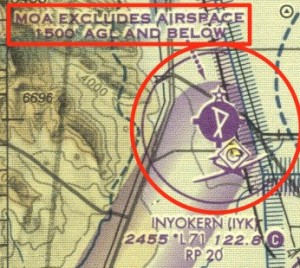Flight Training in (or near) a MOA
Kevin writes:
I’m flying out of Inyokern airport (IYK). It’s just west of the China Lake Naval Air Station and north of Edwards AFB. IYK is within the Isabella MOA if I’m reading my LA sectional correctly. Thanks!
Kevin, I’m not quite sure what you’re asking, but Inyokern lies under, but not within the MOA. The MOA normally starts at 200 feet AGL and extends to FL180. However, over IYK, the MOA begins at 3,956 MSL; this is 1,501 feet above the field elevation of 2,455 feet.

Now, this isn’t exactly a problem, as VFR operations with an MOA simply require that you maintain your own separation from military aircraft. A bigger concern is the Restricted area next door! I would caution you, though, as military aircraft can sometimes get pretty frisky with GA aircraft in a MOA (see the youtube clip of the F-16 intercepting two general aviation aircraft).
The best advice I can offer is for you to check with your instructor and FBO that you will be operating out of to get a thorough briefing of the specific restrictions of your local airspace. You can also check with Flight Service or the controlling ARTCC agency for detailed information on airspace status.
Thanks again for the questions, and always…
Fly safe!


atc on Jan 24, 2009
having worked at china lake before i can tell you that the restricted area is your biggest concern. usually most of the activity in the moa is high altititude but the restricted area is full of live testing from the surface and up. missiles, rockets, unmanned stuff, guns, etc…
depending on the winds ifr aircraft working with approach can get some extra airspace to maneuver to land but never when the restricted area is active which can be anytime.
Eric on Jan 25, 2009
Thanks for the additional information. It’s always great to get feedback and thoughts from ATC regarding airspace and operations.